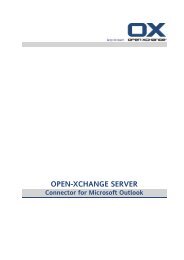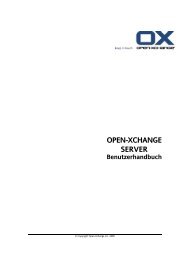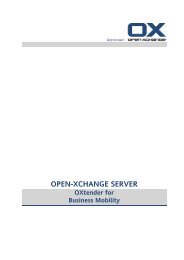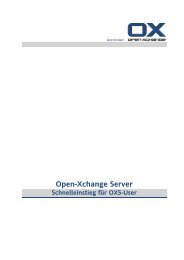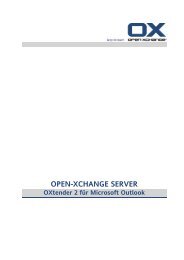Open-Xchange App Suite - Open-Xchange Software Directory
Open-Xchange App Suite - Open-Xchange Software Directory
Open-Xchange App Suite - Open-Xchange Software Directory
You also want an ePaper? Increase the reach of your titles
YUMPU automatically turns print PDFs into web optimized ePapers that Google loves.
<strong>Open</strong>-<strong>Xchange</strong><br />
Product Definition OX <strong>App</strong> <strong>Suite</strong><br />
<strong>Open</strong>-<strong>Xchange</strong> <strong>App</strong> <strong>Suite</strong><br />
V7.0 Community Version<br />
V1.7
Contents<br />
1. Product Descriptions .................................................................................... 3<br />
1.1. <strong>Open</strong>-<strong>Xchange</strong> <strong>App</strong> <strong>Suite</strong> overview ....................................................... 3<br />
1.2. OX <strong>App</strong> <strong>Suite</strong> Server .......................................................................... 3<br />
1.3. OX Web Access ................................................................................. 4<br />
1.4. OX Portal .......................................................................................... 4<br />
1.5. OX PIM ............................................................................................ 4<br />
1.6. OX Files ........................................................................................... 4<br />
1.7. Packages Basic, Advanced & Pro .......................................................... 5<br />
2. OX <strong>App</strong> <strong>Suite</strong> – Module Descriptions ............................................................. 6<br />
2.1. OX Webmail ...................................................................................... 6<br />
2.2. OX Contacts ...................................................................................... 6<br />
2.3. OX Calendar ..................................................................................... 7<br />
2.4. OX Files ........................................................................................... 7<br />
2.5. OX Tasks .......................................................................................... 7<br />
2.6. OX Options ....................................................................................... 8<br />
2.7. OX “Halo View” – People Centric Navigation .......................................... 8<br />
2.8. OX Sharing and Social Functionality ..................................................... 8<br />
2.8.1. Folder Sharing .................................................................................. 8<br />
2.8.2. External Mail Accounts ....................................................................... 8<br />
2.8.3. Social Integration at the Portal ............................................................ 8<br />
3. OX <strong>App</strong> <strong>Suite</strong> Architecture .......................................................................... 10<br />
3.1. OSGi Structure ................................................................................ 10<br />
3.2. Theming Functionality ...................................................................... 10<br />
3.3. Modularization with RequireJS ........................................................... 10<br />
3.4. Extension Points .............................................................................. 10<br />
© Copyright 2012, <strong>Open</strong>-<strong>Xchange</strong> GmbH - 2 -
1. Product Descriptions<br />
1.1. <strong>Open</strong>-<strong>Xchange</strong> <strong>App</strong> <strong>Suite</strong> overview<br />
OX <strong>App</strong> <strong>Suite</strong> has been designed from the ground up to provide a fresh, modern<br />
design that works across devices - tablets, desktops and notebooks - letting you<br />
communicate when you want and where you want. Based on HTML 5, Java Script<br />
and Java OX <strong>App</strong> <strong>Suite</strong> provides a more responsive and robust UI with no loss of<br />
data or app failure if connectivity is interrupted.<br />
OX <strong>App</strong> <strong>Suite</strong> is modular in design and provides standard PIM functionality<br />
through OX Mail, OX Contacts, OX Calendar and OX Tasks. In addition OX Files<br />
provides centralized document management with versioning, publishing, sharing<br />
and file synchronization.<br />
These modules are integrated into the OX Portal, which is highly configurable<br />
and provides one point of access for all OX <strong>App</strong> <strong>Suite</strong> functionality. With a<br />
reduced number of API’s and enhanced modularity OX <strong>App</strong> <strong>Suite</strong> also offers<br />
better integration and extensibility.<br />
Other enhancements include:<br />
• the new “Halo View” which provides people centric navigation based on a<br />
persons social profile (LinkedIn, Facebook, Twitter etc.) and the emails<br />
they have sent, documents shared, common appointments and shared<br />
tasks.<br />
• automatic selection of best preview format for users device<br />
• integrated music and video player<br />
• thread view<br />
• optimized for tablet<br />
• supports multiple email accounts<br />
1.2. OX <strong>App</strong> <strong>Suite</strong> Server<br />
OX Server is a Java based application, which authenticates users, stores and<br />
retrieves user’s information, such as calendar appointments and contacts,<br />
enforces permissions across all of the groupware information and more. OX<br />
Server has been designed to integrate into a hosting provider’s existing<br />
infrastructure leveraging services such as authentication, provisioning, billing,<br />
and email storage rather than require that these systems be replaced.<br />
© Copyright 2012, <strong>Open</strong>-<strong>Xchange</strong> GmbH - 3 -
Java RMI and SOAP APIs, including user creation and modification and command<br />
line tools for provisioning are provided for integration into providers existing<br />
control panel and billing solutions.<br />
1.3. OX Web Access<br />
OX Web Access accomplishes the job of displaying the information stored on the<br />
backend server. This is a newly designed frontend application that runs in the<br />
end-user’s web browser. This application utilizes JavaScript to manipulate the<br />
HTML, DOM and style-sheet properties of the browser page. When the user<br />
changes the state of data, such as uploading a new document, the application<br />
updates the information stored on the backend server.<br />
1.4. OX Portal<br />
The OX Portal is a new module which manages the integration and running of<br />
applications. The Portal allows us to offer a complete new user experience by<br />
tightly integrating OX applications, OX add-ons and external applications into<br />
one portal that can be individually customized by the end user.<br />
The design of this new module is driven by the fact that more and more<br />
applications come from the cloud and the user experience of browser tabs and<br />
bookmarks can be very limiting and unsatisfactory. Additionally the goal is to<br />
provide an enhanced user experience by enabling copy & paste, drag & drop and<br />
program launcher functionality for application and window management.<br />
1.5. OX PIM<br />
<strong>Open</strong>-<strong>Xchange</strong> PIM includes the OX Mails, OX Calendar, OX Contacts and OX<br />
Tasks modules. Besides the most important standard features, OX PIM also<br />
provides webmail users with shared folders, also known as ‘email folder<br />
subscribe /unsubscribe’ (the underlying IMAP server must support email folder<br />
sharing). Additionally users will be able to share and publish OX Contacts and OX<br />
Tasks. For the appointment module a user can use the shared and public<br />
calendars, including privacy controls, Free/Busy, availability checking and<br />
delegated ‘write’ permissions<br />
1.6. OX Files<br />
<strong>Open</strong>-<strong>Xchange</strong> Files provides enhanced file and document management<br />
functionality. A user can store data centrally using OX Files eliminating the need<br />
to attach a document via E-Mail. Versioning of documents is also supported.<br />
Besides the personal OX Files folder, it is also possible to create further public<br />
document folders to share internally & externally with others thus enabling<br />
teamwork functionality across corporate firewalls.<br />
© Copyright 2012, <strong>Open</strong>-<strong>Xchange</strong> GmbH - 4 -
1.7. Packages Basic, Advanced & Pro<br />
With <strong>Open</strong>-<strong>Xchange</strong> <strong>App</strong> <strong>Suite</strong> <strong>Open</strong>-<strong>Xchange</strong> has created three new product<br />
tiers - Basic, Advanced and Pro packages. With the Basic package almost all<br />
features are included, for example the collaboration and sharing features. Going<br />
from Basic to Advanced we recommend certain storage increases and add the<br />
Connector for Business Mobility (EAS). Going from Advanced to Pro, <strong>Open</strong>-<br />
<strong>Xchange</strong> recommends unlimited storage and we add the Connector for Microsoft<br />
Outlook. The two Microsoft ecosystem components are the only exception to the<br />
rule that everything is already included in the Basic package.<br />
© Copyright 2012, <strong>Open</strong>-<strong>Xchange</strong> GmbH - 5 -
2. OX <strong>App</strong> <strong>Suite</strong> – Module Descriptions<br />
2.1. OX Webmail<br />
OX Webmail is a highly sophisticated email solution that can be accessed from<br />
any mainstream web browser. Despite being viewed in a browser OX <strong>App</strong> <strong>Suite</strong><br />
has the look and feel of a fat client. It boasts features such as Drag and Drop,<br />
and threading, as well as standard functionality like create, reply, reply to all.<br />
Besides of email standard folders, webmail allows the creation of complex folder<br />
sub-structures. It is possible to add subfolders and rename and delete them. The<br />
folder view can be hidden to make better use of the available screen real estate<br />
and to present information more clearly., It is possible to mark mails via a<br />
checkbox so further actions can be carried out, such as move or delete, directly<br />
in the mail module.<br />
Webmail allows you to organize folders by date, conversations, from, label,<br />
subject, ascending/descending and unread/read. In addition it is possible to<br />
search all webmail folders.<br />
When sending an email, the webmail module provides the fields to, subject, Cc<br />
and Bcc. And from the create dialog, it is possible to add attachment, signatures<br />
and a personal business cards. The webmail dialog also provides the choice<br />
between HTML and text mails.<br />
Email attachments can be saved to the local disk. When sending an email, users<br />
can access the data in the contact module without having to leave the email<br />
module. If users receive an appointment invitation via E-Mail, it is possible to<br />
switch directly to the appointment entry in the calendar module from within the<br />
email.<br />
2.2. OX Contacts<br />
OX Contacts is used for managing private and business contacts. The user can<br />
view, create, and edit contacts. The contact data for all groupware users is<br />
available in the global address book. It is possible to use the contact data for<br />
sending Email, for inviting participants to appointments from within the calendar<br />
module, or for delegating tasks to other users from within the task module.<br />
Besides creating standard contacts, the user can create distribution lists with<br />
internal and external contacts.<br />
The contact details are shown in an H-Split format, and it is possible to edit the<br />
chosen contact using the optional fields if required. As well as editing and<br />
deleting contacts, it is possible to move and copy contacts in other folders.<br />
© Copyright 2012, <strong>Open</strong>-<strong>Xchange</strong> GmbH - 6 -
2.3. OX Calendar<br />
OX Calendar allows the management of private and business appointments.<br />
Users can view, create, and edit appointments and it is possible to create a<br />
recurring appointment for regular meetings. If additional information is required<br />
users can attach documents to an appointment. If another participant invites<br />
more participants to an appointment, it is possible to accept or decline the<br />
invitation again<br />
If other participants are added to an appointment it is possible to use the data<br />
from the contact module, which is delivered as part of the halo view. Users can<br />
check whether other participants are free for the scheduled appointment and<br />
whether resources such as rooms or devices are available. Other participants are<br />
automatically notified about appointment changes. In additiona it is possible to<br />
create appointments via the inline & create function visible in all views.<br />
The calendar module provides different views for personal and work events. And<br />
it is possible to hide the folder structure of private, public and shared folders. All<br />
important appointment information is visible in the day, workweek, week, month<br />
or list view. By clicking on the appointment a detailed view with all additional<br />
information is displayed. In this view it is possible to edit, delete or change<br />
confirmation of the appointment.<br />
2.4. OX Files<br />
OX Files is a document management app providing photo, music and video<br />
sharing with in app streaming capabilities, document sharing, versioning and<br />
access control. OX Files can also serve as backup location for documents and<br />
other important files.<br />
OX Files also serves as a central information pool for a company's knowledge.<br />
This requires the creation of OX Drive folders that can be shared with other<br />
users or other teams and controlled by allocating read or write permissions.<br />
Users can send OX Files documents as a link or Email attachment to other users.<br />
The module provides icon or H-Split views with a preview of each file type, and<br />
an HTML Editor is included.<br />
2.5. OX Tasks<br />
OX Tasks allows users to view, create, and edit private and business tasks, set<br />
the start and due date and enter the current status of the task. If more detailed<br />
information is required users can attach documents to the task. Users can also<br />
delegate tasks to other participants..<br />
© Copyright 2012, <strong>Open</strong>-<strong>Xchange</strong> GmbH - 7 -
2.6. OX Options<br />
This is where the settings for OX <strong>App</strong> <strong>Suite</strong> are controlled. Here it is possible to<br />
change country settings, the groupware's behavior and design, and personal<br />
settings like password and a vacation notice.<br />
2.7. OX “Halo View” – People Centric Navigation<br />
The new “Halo View” provides people centric navigation based on a person’s<br />
social profile (LinkedIn, Facebook, Twitter etc.) and the emails they have sent,<br />
documents shared, common appointments and shared tasks.<br />
With Halo, users have a summary of all the relevant information relating to a<br />
particular contact in one overview. This means a user can click on an contact, for<br />
example from within the email module, and will be provided with a complete<br />
summary of that contact, including details, recent conversation, received emails,<br />
sent emails and shared appointments and social profile. They can use this<br />
information directly from the overview in a number of ways, for example to<br />
connect via LinkedIn or to set up an appointment directly without having to open<br />
the calendar module.<br />
2.8. OX Sharing and Social Functionality<br />
2.8.1. Folder Sharing<br />
Sharing folders is a vital part of exchanging information with other users. Each<br />
groupware object is saved in a specific folder. Use the folder tree for managing<br />
and sharing folders. Use the personal folders to sort email, contacts, tasks, and<br />
OX File items. Share and collaborate with your team by creating public folders<br />
with read or write access.<br />
2.8.2. External Mail Accounts<br />
External Mail-Accounts like Gmail© or Yahoo© can be integrated directly into the<br />
<strong>Open</strong>-<strong>Xchange</strong> inbox via a configuration wizard. Users simply have to supply<br />
their E-Mail-Address and password and the account will be created automatically<br />
for the above providers. Additional external accounts can be added in the user<br />
configuration page, new mails can then be sent from this account from the<br />
create new mail dialog.<br />
2.8.3. Social Integration at the Portal<br />
Social accounts like Facebook©, Twitter© or RSS Feeds can be set up and<br />
integrated into the Portal page, where a user can display (read only) information<br />
© Copyright 2012, <strong>Open</strong>-<strong>Xchange</strong> GmbH - 8 -
from their accounts. In addition it is possible to integrate Tumblr© Picture Feeds<br />
and Flickr© Picture Streams.. Social integration on the portal page can be<br />
activated or disabled from the settings page.<br />
© Copyright 2012, <strong>Open</strong>-<strong>Xchange</strong> GmbH - 9 -
3. OX <strong>App</strong> <strong>Suite</strong> Architecture<br />
<strong>Open</strong>-<strong>Xchange</strong> <strong>App</strong> <strong>Suite</strong> is built to be deployed in a wide variety of<br />
environments and usage scenarios. To achieve this, it is built with extensibility<br />
and customization in mind and utilizes the folowing technologies:<br />
3.1. OSGi Structure<br />
On the backend, we use a service platform and module system called OSGi. It<br />
allows us to separate functionality into modules and abstract services as Java<br />
interfaces. Our backend comes with a range of SPIs that you can implement to<br />
plug in to your own mail system for example (authentication system, contact<br />
store, file store etc.) or implement your own backend functionality for use by the<br />
UI. A typical scenario is writing a custom authentication scheme for an<br />
installation, so the <strong>App</strong> <strong>Suite</strong> seamlessly plugs into your existing architecture.<br />
3.2. Theming Functionality<br />
To enable theming and branding of the frontend, we use less.js, a css<br />
precompiler that enhances CSS by introducing some programming concepts<br />
(variables, mixins, functions and calculations). Thanks to this branding, or<br />
creating a theme is very straightforward.<br />
3.3. Modularization with RequireJS<br />
'RequireJS' implements a modularization system (called "AMD", Asynchronous<br />
Module Definition). This enables the frontend to incrementally load parts of the<br />
program or assets when it needs them. This increases the perceived speed of the<br />
application and, more importantly, enables us to separate the frontend into<br />
logical sub modules without tainting the global namespace – otherwise a<br />
common javascript ailment.<br />
3.4. Extension Points<br />
Extension points allow plugins to add extra features and functionality to nearly<br />
all aspects of the frontend, which in turn may offer extension points themselves.<br />
This architecture is used rigorously in the <strong>App</strong> <strong>Suite</strong> Frontend allowing a wide<br />
range of extensibility. As an example, consider the detail view of a mail<br />
message. It offers an extension point for mail renderers. This extension point is<br />
extended by, for example the renderer for the message subject, the renderer for<br />
the message body, the renderer for message attachments and an extension that<br />
draws the menu with the inline actions. This last one again offers an extension<br />
point that is extended by all the actions you can perform with a mail message<br />
© Copyright 2012, <strong>Open</strong>-<strong>Xchange</strong> GmbH - 10 -
(forward it, reply to it, etc.). So, if you wanted to offer an additional action to be<br />
performed with mail, you can do so by extending the menu's extension point. If<br />
you wanted to show additional data in the mail view (say, because your mail<br />
system sets a unique header with information for employees in it), you could<br />
extend the detail view's extension point to display the data. All extensions can<br />
be disabled or replaced entirely with your own custom ones.<br />
The Extension Point system is used extensively in the UI, to ensure you can<br />
extend every part of the frontend.<br />
© Copyright 2012, <strong>Open</strong>-<strong>Xchange</strong> GmbH - 11 -



